Zebra Profile
Zebras (subgenus Hippotigris) are well-known for their distinctive stripes. They are members of the group Equus, which contains horses and asses.
There are three living species of Zebra: the plains zebra (Equus quagga), the grevy’s zebra (Equus grevyi), and the mountain zebra (Equus zebra). Each species has unique stripes.
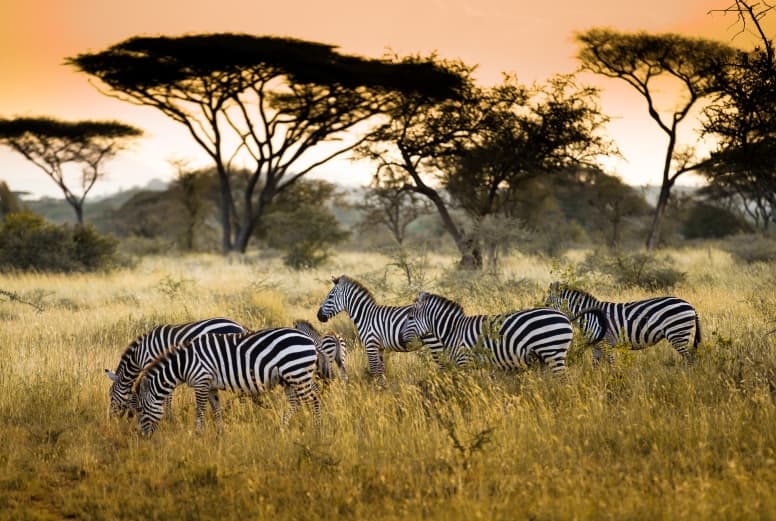
Zebra Facts Overview
| Habitat: | Grasslands, woodlands, savannahs, and mountainous areas. |
| Location: | Eastern and Southern Africa |
| Lifespan: | Around 25 years |
| Size: | 110 – 160cm at the shoulder, and 7-10ft in body length |
| Weight: | Grevy’s zebra: 350-450kg, the plain zebra: 175-385kg, and the mountain zebra: 200-430kg. |
| Color: | Black with white stripes |
| Diet: | Herbivores, mainly grass |
| Predators: | Lions, cheetahs, leopards, spotted hyenas, brown hyenas and Nile crocodiles. |
| Top Speed: | 58 kph (36 mph) |
| No. of Species: | 3 |
| Conservation Status: | Grevy’s zebra: endangered, mountain zebra: vulnerable, plains zebra: near-threatened. |
Zebras are native to the continent of Africa, specifically eastern and southern parts such as Kenya and Botswana. Favoured habitats include grasslands, woodlands, savannahs, and mountainous areas.
They are grazers, feeding mainly on grasses. They are well evolved for this with strong front teeth to pull up the grass and large molars in the back of their mouths for grinding.
They are the favourite prey of lions, but are also hunted by leopards, cheetahs, spotted hyenas, brown hyenas, and Nile crocodiles.
According to the IUCN’s conservation status, the Grevy’s Zebra is endangered with approx. 2,250 individuals, while the mountain zebra is vulnerable, and the plains zebra is near threatened. Their decline is down to loss of habitat, illegal poaching, disease, and civil wars have also caused a drop in zebra populations.
Zebras can be found in numerous protected areas and parks, which are aiming to help halt the decline, offer access to water, and increase their chances of survival.
Interesting Zebra Facts
1. Their stripes are unique
Zebras are iconic for their stripes, which are actually unique to each individual, like a human’s fingerprint.
Scientists have even developed a way to read their stripes like bar codes to be able to identify specific zebras in a heard. 1
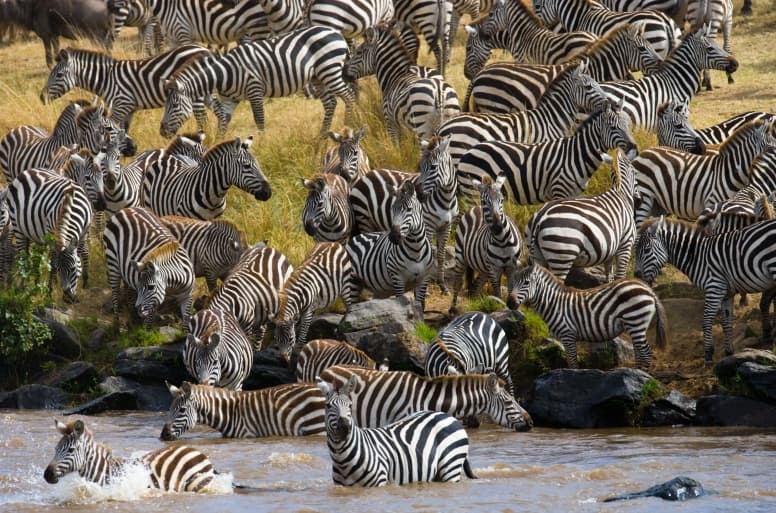
2. Zebra’s stripes are further apart the further south in Africa
Studies have shown that the further south on the African plains you travel, the farther apart the stripes of zebras are.
Each species of zebra has different types of stripes, too. The the grevy’s zebra has the thinnest stripes, while the moutain zebra has vertical stripes on its neck and torso.
3. No one is completely sure why they have stripes
There have been lots of theories, including that the stripes help confuse predators.
Some theories suggest that the stripes work to keep them cooler, while others show that biting flies don’t like to land on stripes. It’s likely to be a combination of all these things! 2
4. They are black with white stripes
The age-old question of whether or not zebras are white with black stripes or black with white stripes has finally been answered with science.
They are generally thought of as white with black stripes, but they are in fact black with white stripes! Zebras have black skin under their hair, too. 3
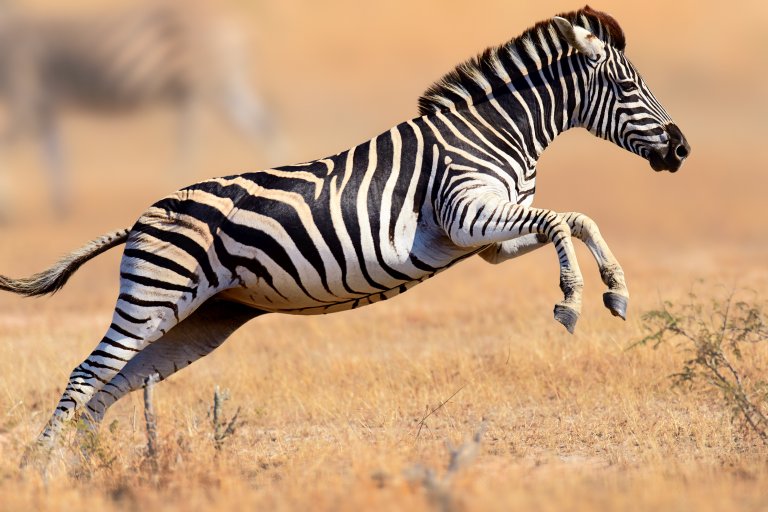
5. Different zebra species have different social structures
The plains and mountain zebras stay in family groups, with a dominate male, females and their foals (baby zebras). These groups usually integrate into larger herds.
However, the grevy’s zebra lives primarily alone, or in loose herds. The males have territories which they protect from others, while females and their foals move freely between these territories.
6. Plains zebra migrate and form super herds
Plains zebra are the most abundant of the three species and are known for their long migrations, moving to different areas in search of water and grass.
Multiple family groups come together to form herds. Often as herds are migrating, they form ‘super herds’ with thousands of zebras. Other herd animals join in too, such as wildebeest and antelope.
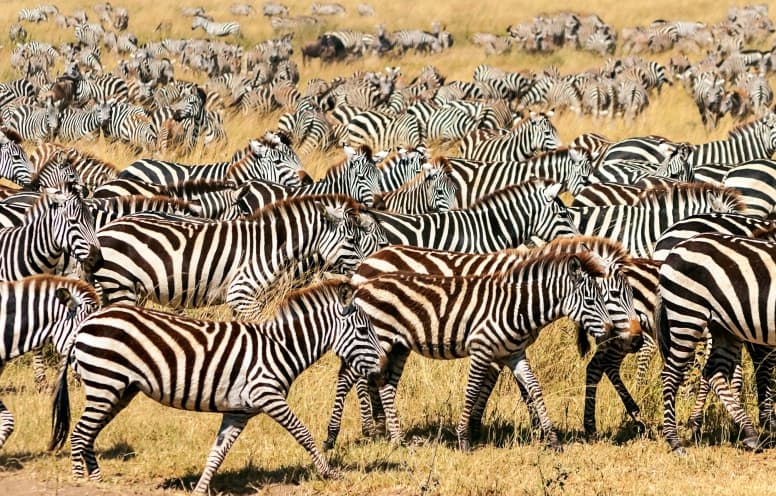
7. Plains zebra mass migrate in Botswana twice a year
They move from north to south to reach the rainy season in the Makgadikgadi Salt Pans, before returning back to reach the northern deltas again as the rainy season there returns.
This migration is around 300 miles and the moving herds contain up to 30,000 zebra.
8. Plains zebra have the longest recorded migration of any African mammal
One group of plains zebra was recorded migrating 500km from Namibia to Botswana, which is actually the longest land migration of any African mammal. 4
9. They are well adapted for grazing and staying alert for predators
They have long front teeth (incisors) which act like scissors to cut the grass at the root, while their large back teeth (molars) work to grind down the grass.
They also have eyes high up on the sides of their heads. This means that as they bend down to eat grass they can still watch for lions, or other predators.
10. They are best friends with wildebeest
Zebra take part in the great wildebeest migration towards the north based on weather patterns.
During this migration, they depend on one another for survival. Wildebeest have excellent hearing and smell, while zebra have exceptional vision.
Working together collectively in a pack helps them reduce risk of predation. Despite this, it’s thought that over 250,000 zebra die each year during the migration.

11. They bite and kick
Zebras can perhaps surprisingly be aggressive. This is usually when defending themselves from prey, defending their young, or when males are fighting over a female.
Their primary tactics are biting and kicking, as you can see in this video:
12. They defend each other
The social species of zebra will protect their members from predators.
They have been seen forming defensive circles around injured members of their families or foals, often biting and kicking approaching predators.
13. They are one of the worlds fastest land animals
Zebra are fast and agile with long slender legs enabling them to move at high speed.
They are capable of running at speeds of 58 kph (36 mph), which is faster than some of their predators, including lions.
They’re good with endurance, as well, which gives them an advantage over most ambush predators, as long as they avoid the initial lunge.

14. The grevy’s zebra is the largest zebra species
The grevy’s zebra has a stocky mule-like physique and measure up to 10ft in body length, and 5ft in height. They weight between 350-450kg (776 – 992 lb), have the thinnest stripes and largest ears.
The plans zebra is the smallest of the species, with shorter legs and more closely resemble a horse. Their body length can reach up to around 8 ft, with a height of under 5 ft and weighing between 175 – 385kg (385 – 850 lb).
The mountain zebra is somewhere between the other two species in size, and has vertical stripes on its neck and torso.
15. There are 8 subspecies of zebra
Plains zebra subspecies include the maneless zebra, grant’s zebra, crawshay’s zebra, chapman’s zebra, burchell’s zebra, and selous’ zebra, which have different geographical distributions.
Mountain zebras are divided into two subspecies. Hartmann’s mountain zebra (Equus zebra zebra) and Cape mountain zebra (Equus zebra zebra) (Equus zebra hartmannae). Both prefer mountainous regions in Angola, Namibia, and South Africa.
There are no grévy’s zebra subspecies.
16. The cape mountain zebra nearly went extinct
In 1930 there were as few as 100 cape mountain zebra, however thanks to conservation efforts their numbers have increased dramtically up towards 3,000. 5

17. The quagga subspecies went extinct in the 19th century
The quagga (Equus quagga quagga) was a subspecies of the plains zebra endemic to South Africa.
Sadly, European colonists hunted them to extinction in the 19th century. The last one died in Amsterdam zoo in 1883.
18. They are important culturally
They are well known internationally, but are also important locally. They can be seen in art going back millennia, including in rock art from roughly 20,000 years ago.
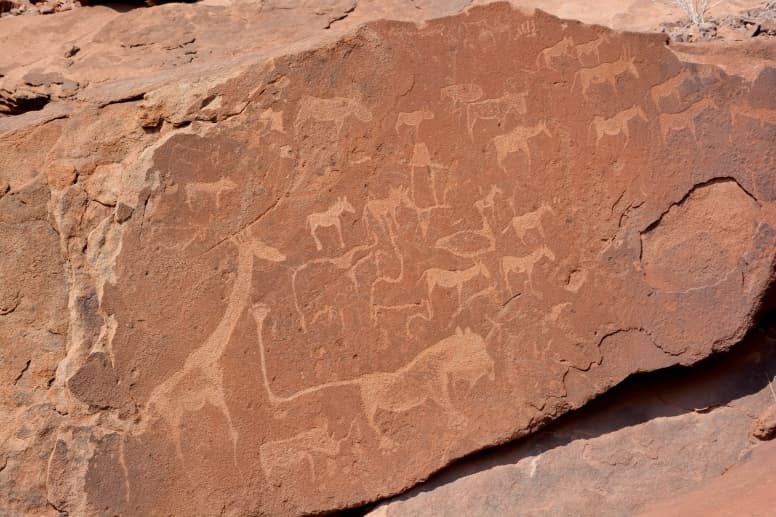
19. The grevy’s zebra wild population is as little as just 2,250 individuals
The grevy’s zebra is endangered according to the IUCN Redlist. Its population size was estimated to be around 15,000 in the 1970’s, and has declined to closer to 2,000 today.
Historically poaching was the primary cause of their decline, with beautiful zebra skin fetching high prices across the globe. However, today their main threat is habitat loss, competition with livestock, disease and invasive species of plant endangering their food supply.
Zebra Fact-File Summary
Scientific Classification
| Kingdom: | Animalia |
| Phylum: | Chordata |
| Class: | Mammalia |
| Order: | Perissodactyla |
| Family: | Equidae |
| Genus: | Equus |
| Sub Genus: | Hippotigri |
| Species Names: | The grévy’s zebra (Equus grevyi) Plains zebra (Equus quagga) The mountain zebra (Equus zebra) |
Fact Sources & References
- Boyle R. New Scanner Tracks Zebras’ Built-In Bar Codes | Popular Science. Accessed February 22, 2021.
- How MJ, Gonzales D, Irwin A, Caro T. Zebra stripes, tabanid biting flies and the aperture effect. Proc R Soc B Biol Sci. 2020;287(1933):20201521. doi:10.1098/rspb.2020.1521
- Villazon L. Are zebras black with white stripes or white with black stripes? – BBC Science Focus Magazine. Accessed February 23, 2021.
- Naidoo R, Chase MJ, Beytell P, et al. A newly discovered wildlife migration in Namibia and Botswana is the longest in Africa. ORYX. 2016;50(1):138-146. doi:10.1017/S0030605314000222
- Hrabar H, Kerley GIH. Conservation goals for the Cape mountain zebra Equus zebra zebra – Security in numbers? ORYX. 2013;47(3):403-409. doi:10.1017/S0030605311002018
